Paper Menu >>
Journal Menu >>
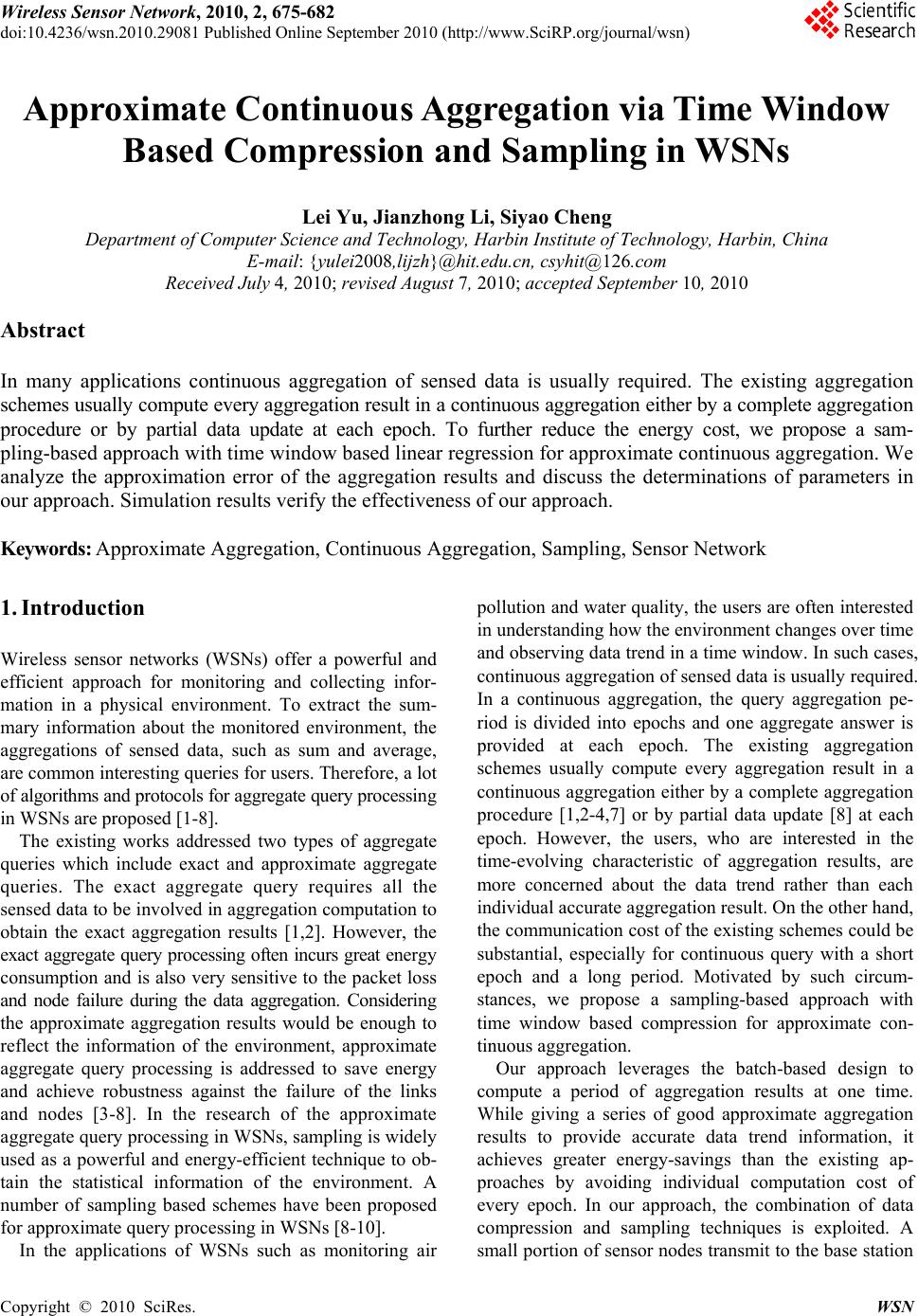 Wireless Sensor Network, 2010, 2, 675-682 doi:10.4236/wsn.2010.29081 Published Online September 2010 (http://www.SciRP.org/journal/wsn) Copyright © 2010 SciRes. WSN Approximate Continuous Aggregation via Time Window Based Compression and Sampling in WSNs Lei Yu, Jianzhong Li, Siyao Cheng Department of Computer Science and Technology, Harbin Institute of Technology, Harbin, China E-mail: {yulei2008,lijzh}@hit.edu.cn, csyhit@126.com Received July 4, 2010; revised August 7, 2010; accepted September 10, 2010 Abstract In many applications continuous aggregation of sensed data is usually required. The existing aggregation schemes us ually comput e every aggrega tion resu lt in a con tinuous a ggregat ion eith er by a co mplete aggr egat i o n procedure or by partial data update at each epoch. To further reduce the energy cost, we propose a sam- pling-based approach with time window based linear regression for approximate continuous aggregation. We analyze the approximation error of the aggregation results and discuss the determinations of parameters in our approach. Simulation results verify the effectiveness of our approach. Keywords: Approximate Aggregation, Continuous Aggregation, Sampling, Sensor Network 1. Introduction Wireless sensor networks (WSNs) offer a powerful and efficient approach for monitoring and collecting infor- mation in a physical environment. To extract the sum- mary information about the monitored environment, the aggregations of sensed data, such as sum and average, are common interesting queries for users. Therefore, a lot of algorithms and protocols for aggregate query processin g in WSNs are proposed [1-8]. The existing works addressed two types of aggregate queries which include exact and approximate aggregate queries. The exact aggregate query requires all the sensed data to be involved in aggregation computation to obtain the exact aggregation results [1,2]. However, the exact aggregate query processing often incurs great energy consumption and is also very sensitive to the packet loss and node failure during the data aggregation. Considering the approximate aggregation results would be enough to reflect the information of the environment, approximate aggregate query processing is addressed to save energy and achieve robustness against the failure of the links and nodes [3-8]. In the research of the approximate aggregate query processing in WSNs, sampling is widely used as a powerful and energy-efficient technique to ob- tain the statistical information of the environment. A number of sampling based schemes have been proposed for approximate query processing in WSNs [8-10]. In the applications of WSNs such as monitoring air pollution and water quality, the users are often interested in understanding how the environment changes over time and observing da ta trend in a time window. In such cases, continuous aggr egation of sensed data is usually req uired. In a continuous aggregation, the query aggregation pe- riod is divided into epochs and one aggregate answer is provided at each epoch. The existing aggregation schemes usually compute every aggregation result in a continuous aggregation either by a complete aggregation procedure [1,2-4,7] or by partial data update [8] at each epoch. However, the users, who are interested in the time-evolving characteristic of aggregation results, are more concerned about the data trend rather than each individual accurate aggregation result. On the other hand, the communication cost of the existing schemes could be substantial, especially for continuous query with a short epoch and a long period. Motivated by such circum- stances, we propose a sampling-based approach with time window based compression for approximate con- tinuous aggregation. Our approach leverages the batch-based design to compute a period of aggregation results at one time. While giving a series of good approximate aggregation results to provide accurate data trend information, it achieves greater energy-savings than the existing ap- proaches by avoiding individual computation cost of every epoch. In our approach, the combination of data compression and sampling techniques is exploited. A small portion of sensor nodes transmit to the base station 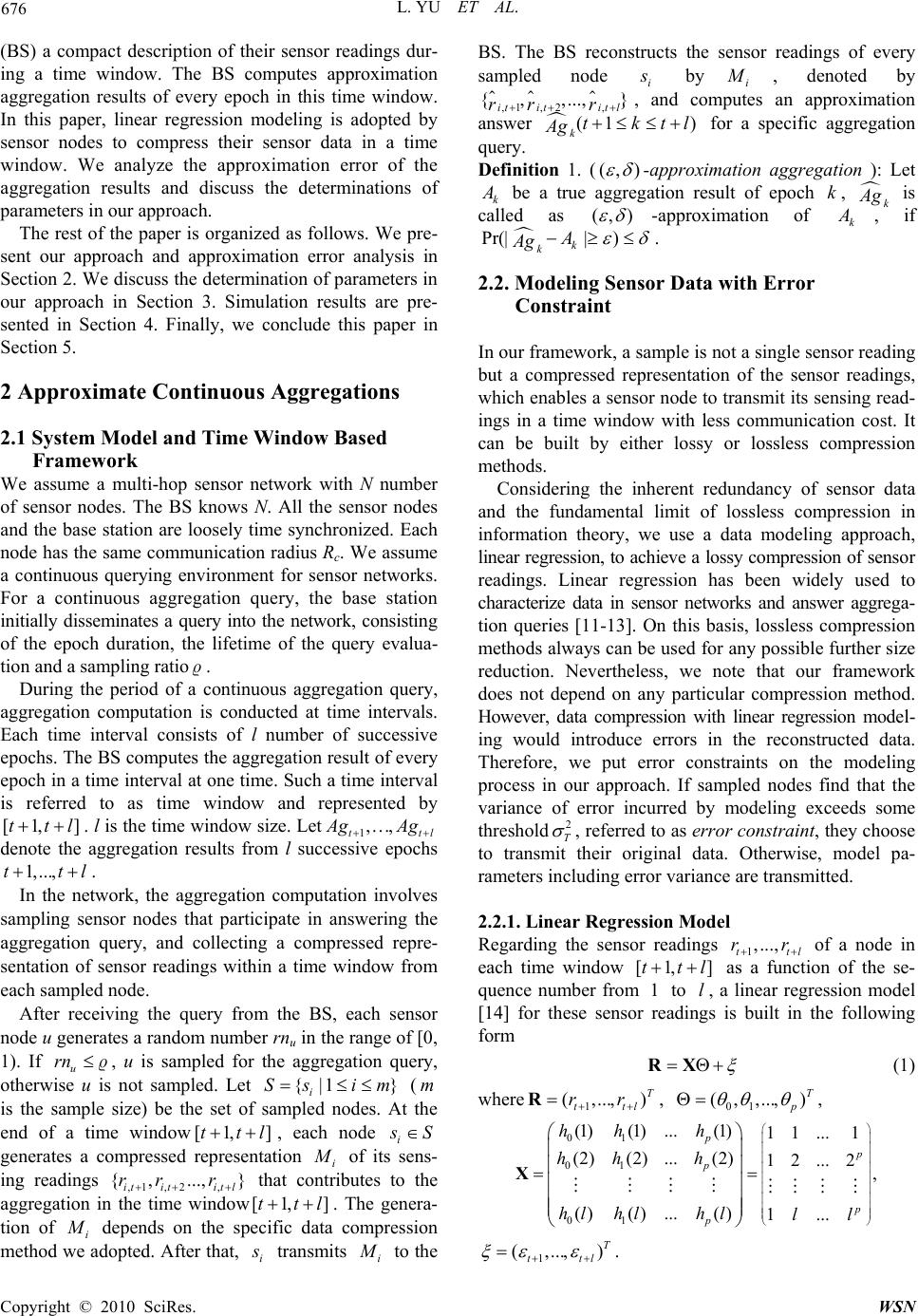 L. YU ET AL. Copyright © 2010 SciRes. WSN 676 (BS) a compact description of their sensor readings dur- ing a time window. The BS computes approximation aggregation results of every epoch in this time window. In this paper, linear regression modeling is adopted by sensor nodes to compress their sensor data in a time window. We analyze the approximation error of the aggregation results and discuss the determinations of parameters in our approach. The rest of the paper is organized as follows. We pre- sent our approach and approximation error analysis in Section 2. We discuss the determination of parameters in our approach in Section 3. Simulation results are pre- sented in Section 4. Finally, we conclude this paper in Section 5. 2 Approximate Continuous Aggregations 2.1 System Model and Time Window Based Framework We assume a multi-hop sensor network with N number of sensor nodes. The BS knows N. All the sensor nodes and the base station are loosely time synchronized. Each node has the same communication radius Rc. We assume a continuous querying environment for sensor networks. For a continuous aggregation query, the base station initially disseminates a query into the network, consisting of the epoch duration, the lifetime of the query evalua- tion and a sampling ratio. During the period of a continuous aggregation query, aggregation computation is conducted at time intervals. Each time interval consists of l number of successive epochs. The BS computes the aggregation result of every epoch in a time interval at one time. Such a time interval is referred to as time window and represented by [1 ]ttl . l is th e time window size. Let1… ttl A gAg denote the aggregation results from l successive epochs 1,...ttl . In the network, the aggregation computation involves sampling sensor nodes that participate in answering the aggregation query, and collecting a compressed repre- sentation of sensor readings within a time window from each sampled node. After receiving the query from the BS, each sensor node u generates a random number rnu in the range of [0, 1). If u rn , u is sampled for the aggregation query, otherwise u is not sampled. Let {1 } i Ss im (m is the sample size) be the set of sampled nodes. At the end of a time window[1 ]ttl , each node i s S generates a compressed representation i M of its sens- ing readings 12 {} ititit l rr r that contributes to the aggregation in the time window[1 ]ttl . The genera- tion of i M depends on the specific data compression method we adopted. After that, i s transmits i M to the BS. The BS reconstructs the sensor readings of every sampled node i s byi M , denoted by 12 {,} ititit l rr r , and computes an approximation answer (1 ) ktktl Ag for a specific aggregation query. Definition 1. (() -approximation aggregation ): Let k A be a true aggregation result of epoch k, k A g is called as () -approximation of k A , if Pr( ) k kA Ag . 2.2. Modeling Sensor Data with Error Constraint In our framework, a sample is not a single sensor reading but a compressed representation of the sensor readings, which enables a sensor node to transmit its sensing read- ings in a time window with less communication cost. It can be built by either lossy or lossless compression methods. Considering the inherent redundancy of sensor data and the fundamental limit of lossless compression in information theory, we use a data modeling approach, linear regression, to achieve a lossy compression of senso r readings. Linear regression has been widely used to characterize data in sensor networks and answer aggrega- tion queries [11-13]. On this basis, lossless compression methods always can be used for any possible further size reduction. Nevertheless, we note that our framework does not depend on any particular compression method. However, data compression with linear regression model- ing would introduce errors in the reconstructed data. Therefore, we put error constraints on the modeling process in our approach. If sampled nodes find that the variance of error incurred by modeling exceeds some threshold 2 T , referred to as error constraint, they choose to transmit their original data. Otherwise, model pa- rameters including error variance are transmitted. 2.2.1. Linear Regression Model Regarding the sensor readings 1ttl rr of a node in each time window [1 ]ttl as a function of the se- quence number from 1 to l, a linear regression model [14] for these sensor readings is built in the following form RX (1) where 1 (...) T ttl rr R, 01 (... )T p , 01 01 01 (1)(1) ...(1)11...1 (2)(2) ...(2)1 2 ... 2 ()() ...()1... p p p p p hh h hh h hl hlhlll X 1 ( ... )T ttl . 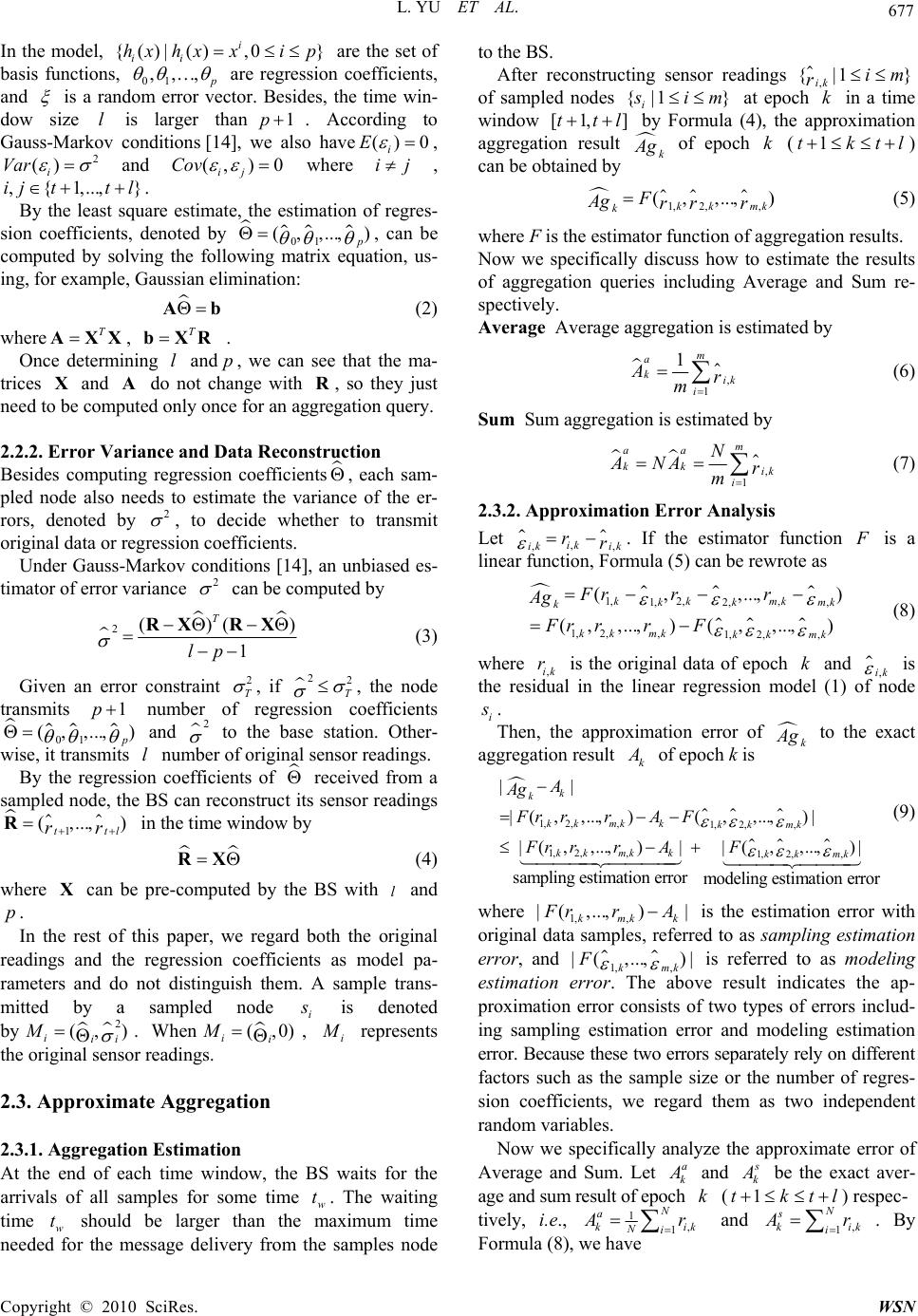 L. YU ET AL. Copyright © 2010 SciRes. WSN 677 In the model, {() ()0} i ii hx hxxip are the set of basis functions, 01 … p are regression coefficients, and is a random error vector. Besides, the time win- dow size l is larger than1p. According to Gauss-Markov conditions [14], we also have() 0 i E , 2 () i Var and ()0 ij Cov where ij , {1... }ijttl . By the least square estimate, the estimation of regres- sion coefficients, denoted by 01 (...) p , can be computed by solving the following matrix equation, us- ing, for example, Gaussian elimination: Ab (2) where T AXX , T bXR . Once determining l andp, we can see that the ma- trices X and A do not change with R, so they just need to be computed only once for an aggregation query. 2.2.2. Error Variance and Dat a Rec ons tru ction Besides computing regression coefficients , each sam- pled node also needs to estimate the variance of the er- rors, denoted by 2 , to decide whether to transmit original data or regression coefficients. Under Gauss-Markov conditions [14], an unbiased es- timator of error variance 2 can be computed by 2()() 1 T lp RXRX (3) Given an error constraint 2 T , if 22 T , the node transmits 1p number of regression coefficients 01 (...) p and 2 to the base station. Other- wise, it transmits l number of original sensor readings. By the regression coefficients of received from a sampled node, the BS can reconstruct its sensor readings 1 ( ... ) ttl rr R in the time window by RX (4) where X can be pre-computed by the BS with l and p. In the rest of this paper, we regard both the original readings and the regression coefficients as model pa- rameters and do not distinguish them. A sample trans- mitted by a sampled node i s is denoted by 2 () iii M . When (0) ii M , i M represents the original sensor readings. 2.3. Approximate Aggregation 2.3.1. Aggre ga tion Estimation At the end of each time window, the BS waits for the arrivals of all samples for some time w t. The waiting time w t should be larger than the maximum time needed for the message delivery from the samples node to the BS. After reconstructing sensor readings {1 } ik im r of sampled nodes {1 } i s im at epoch k in a time window [1 ]ttl by Formula (4), the approximation aggregation result k A g of epoch k (1tktl ) can be obtained by 12 (...) kk mk kF Ag rr r (5) where F is the estimator function of aggregation results. Now we specifically discuss how to estimate the results of aggregation queries including Average and Sum re- spectively. Average Average aggregation is estimated by 1 1m a kik i Ar m (6) Sum Sum aggregation is estimated by 1 m aa kk ik i N ANA r m (7) 2.3.2. Approxi m ation Error Analysis Let ik ik ik rr . If the estimator function F is a linear function, Formula (5) can be rewrote as 12 12 12 12 (... ) (... ) (...) kk mk kk mk k kk mkkk mk Fr rr Ag Fr rrF (8) where ik r is the original data of epoch k and ik is the residual in the linear regression model (1) of node i s . Then, the approximation error of k A g to the exact aggregation result k A of epoch k is 12 12 12 12 (...)(...) (... )(...) samplingestimation errormodeling estimation error k k kk mkkkk mk kk mkkkk mk A Ag Fr rrAF Fr rrAF (9) where 1 ( ...) kmk k F rr A is the estimation error with original data samples, referred to as sampling estimation error, and 1 ( ...) kmk F is referred to as modeling estimation error. The above result indicates the ap- proximation error consists of two types of errors includ- ing sampling estimation error and modeling estimation error. Because these two errors separately rely on differe nt factors such as the sample size or the number of regres- sion coefficients, we regard them as two independent random variables. Now we specifically analyze the approximate error of Average and Sum. Let a k A and s k A be the exact aver- age and sum result of epoch k (1tktl ) respec- tively, i.e., 11 N a kik Ni A r and 1 N s kik i A r . By Formula (8), we have 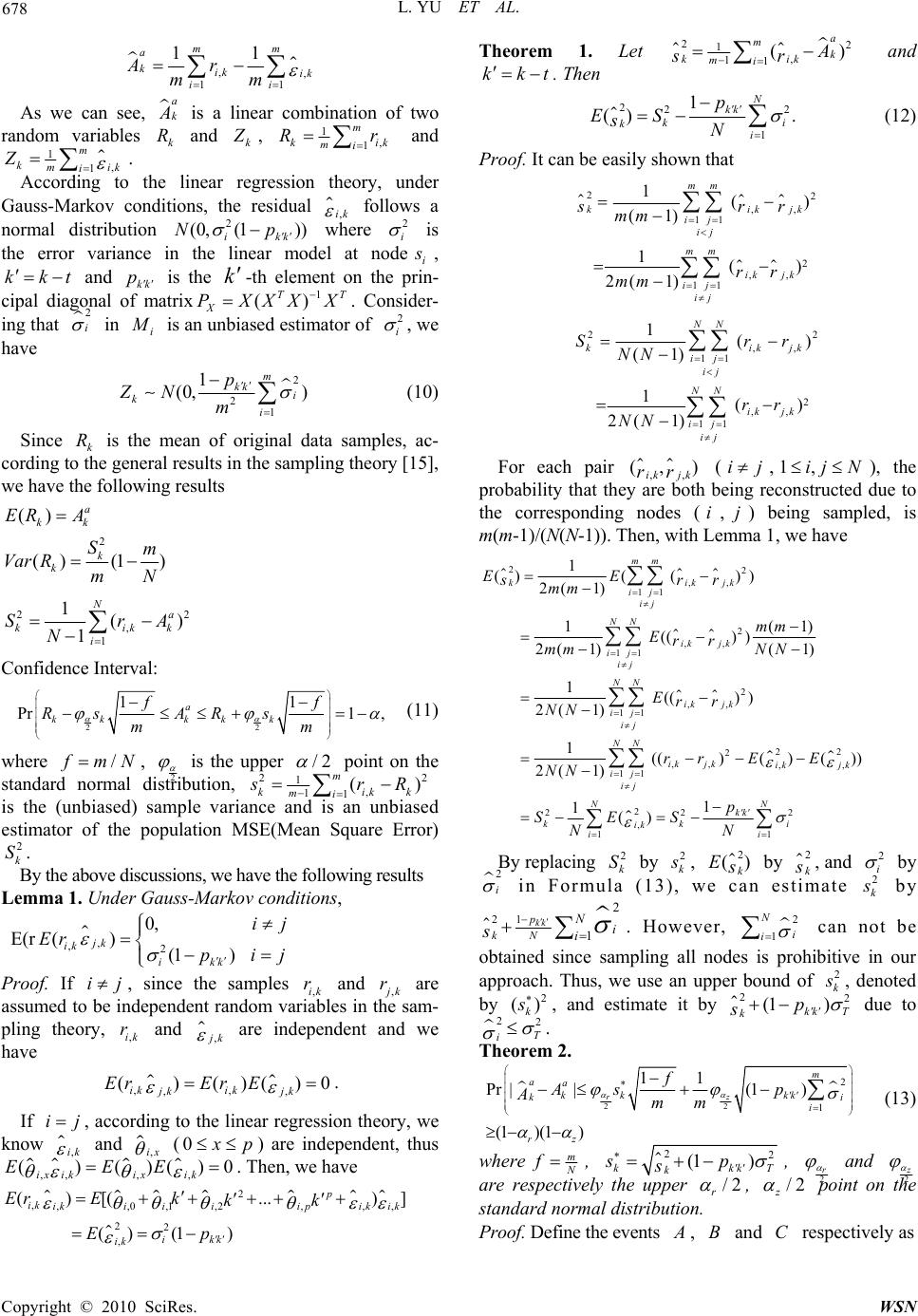 L. YU ET AL. Copyright © 2010 SciRes. WSN 678 11 11 mm a kik ik ii Ar mm As we can see, a k A is a linear combination of two random variables k R and k Z , 11 m kik mi Rr and 11 m kik mi Z . According to the linear regression theory, under Gauss-Markov conditions, the residual ik follows a normal distribution 2 (0 (1)) ikk Np where 2 i is the error variance in the linear model at nodei s , kkt and kk p is the k -th element on the prin- cipal diagonal of matrix1 () TT X PXXXX . Consider- ing that 2 i in i M is an unbiased esti mator of 2 i , we have 2 21 1 (0 ) m kk i ki p ZN m (10) Since k R is the mean of original data samples, ac- cording to the general results in the sampling theory [15], we have the following results () a kk ER A 2 ()(1) k k Sm Var RmN 22 1 1() 1 Na kikk i SrA N Confidence Interval: 22 11 Pr 1 a kk kkk ff Rs ARs mm (11) where f mN, 2 is the upper 2 point on the standard normal distribution, 22 111() m kikk mi srR is the (unbiased) sample variance and is an unbiased estimator of the population MSE(Mean Square Error) 2 k S. By the above discussions, we have the following results Lemma 1. Under Gauss-Markov conditions, E(r , ,2 0, ()(1) jk ik ikk ij Er pij Proof. If ij, since the samples ik r and j k r are assumed to be independent random variables in the sam- pling theory, ik r and j k are independent and we have ()()()0 ik ik jk jk ErEr E . If ij, according to the linear regression theory, we know ik and ix (0 x p) are independent, thus ()()()0 ix ikixik EEE . Then, we have 2 01 2 22 ()[(... )] () (1) p ik ikiiiipik ik ikk ik ErEk kk Ep Theorem 1. Let 22 111() a mk ik kmiA sr and kkt . Then 222 1 1 () N kk ki ki p ES sN (12) Proof. It can be easily shown that 22 11 2 11 1() (1) 1() 2( 1) mm ik jk kij ij mm ik jk ij ij srr mm rr mm 22 11 2 11 1() (1) 1() 2( 1) NN kikjk ij ij NN ik jk ij ij Srr NN rr NN For each pair () ik jk rr (ij,1ij N ), the probability that they are both being reconstructed due to the corresponding nodes (i,j) being sampled, is m(m-1)/(N(N-1)). Then, with Lemma 1, we have 22 11 2 11 2 11 22 2 11 2 1 1 ()( ()) 2( 1) 1(1) (()) 2( 1)(1) 1(()) 2( 1) 1(()( )()) 2( 1) 1 mm ik jk kij ij NN ik jk ij ij NN ik jk ij ij NN ik jkik jk ij ij ki EE srr mm mm Err mm NN Err NN rr EE NN SN 222 1 1 () NN kk ki ik i p ES N By replacing 2 k S by 2 k s , 2 () k E s by 2 k s , and 2 i by 2 i in Formula (13), we can estimate 2 k s by 1 22 1 kk p kN Ni i s . However, 2 1 N i i can not be obtained since sampling all nodes is prohibitive in our approach. Thus, we use an upper bound of 2 k s , denoted by 2 () k s , and estimate it by 22 (1 ) kk T kp s due to 22 T i . Theorem 2. 22 2 1 11 Pr(1 ) (1 )(1 ) rz m aa kk kk ki i rz f As p Amm (13) where m N f , 22 (1 ) kkkT k sp s , 2 r and 2 z are respectively the upper 2 r , 2 z point on the standard normal distribution. Proof. Define the events A , B and C respectively as 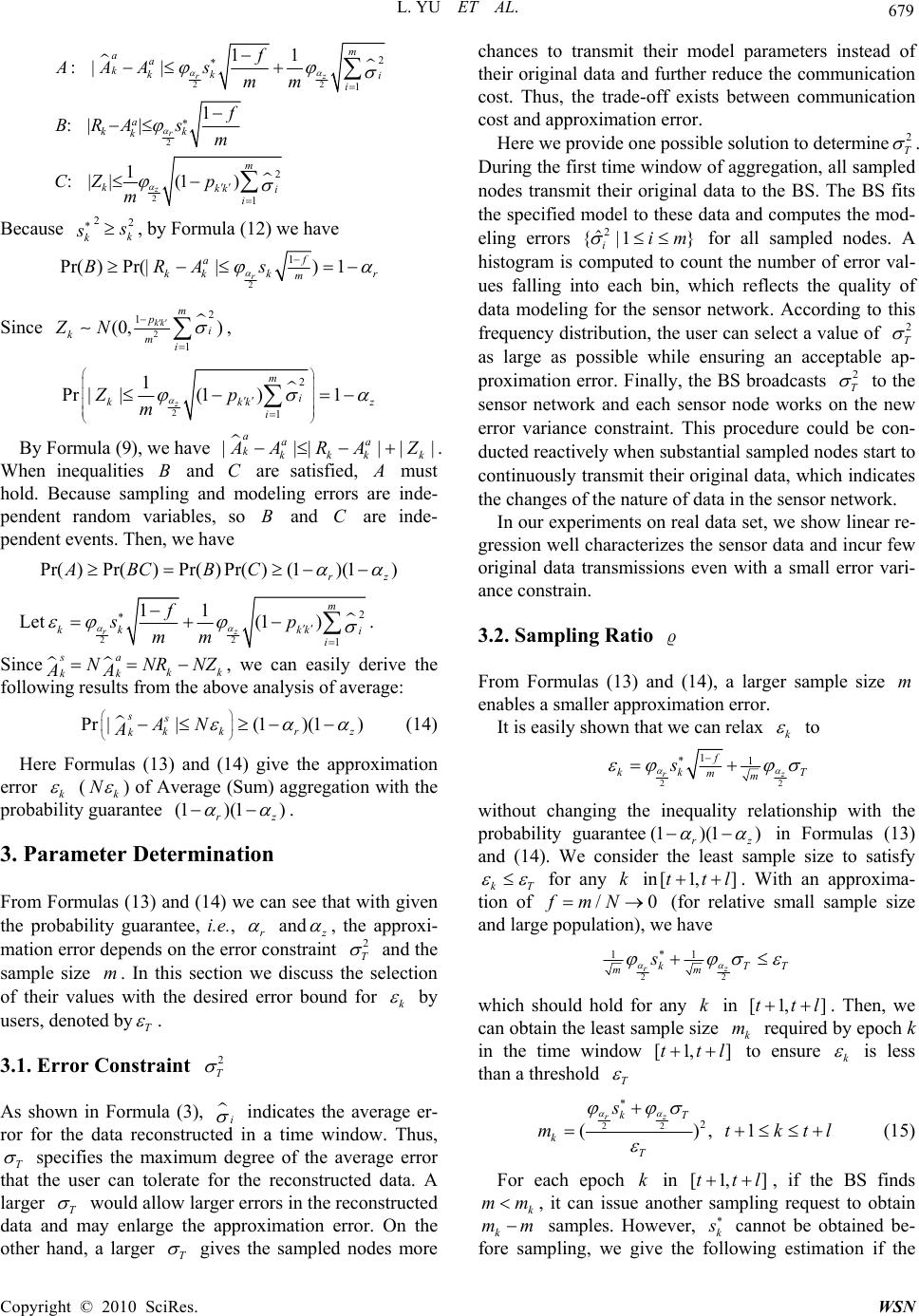 L. YU ET AL. Copyright © 2010 SciRes. WS N 679 22 2 2 2 1 2 1 11 1 1(1 ) rz r z m aa kkk i i a kk k m kkk i i f AAA smm f BRAs m CZ p m Because 22 k k s s, by Formula (12) we have 2 1 Pr()Pr()1 r f a kk kr m BRAs Since 2 2 1 1 (0) kk m pi kmi ZN , 2 2 1 1 Pr(1 )1 z m i kkkz i Zp m By Formula (9), we have aaa kkkk k A ARA Z . When inequalities B and C are satisfied, A must hold. Because sampling and modeling errors are inde- pendent random variables, so B and C are inde- pendent events. Then, we have Pr()Pr()Pr( )Pr( )(1)(1) rz ABCBC Let 22 2 1 11 (1 ) rz m kk kk i i f sp mm . Since sa kk kk NNRNZ AA , we can easily derive the following results from the above analysis of average: Pr(1 )(1) ss kk rz kAN A (14) Here Formulas (13) and (14) give the approximation error k (k N ) of Average (Sum) aggregation with the probability guarantee (1)(1) rz . 3. Parameter Determination From Formulas (13) and (14) we can see that with given the probability guarantee, i.e., r and z , the approxi- mation error depends on the error constraint 2 T and the sample size m. In this section we discuss the selection of their values with the desired error bound for k by users, denoted byT . 3.1. Error Constraint 2 T As shown in Formula (3), i indicates the average er- ror for the data reconstructed in a time window. Thus, T specifies the maximum degree of the average error that the user can tolerate for the reconstructed data. A larger T would allow larger errors in the reconstructed data and may enlarge the approximation error. On the other hand, a larger T gives the sampled nodes more chances to transmit their model parameters instead of their original data and further reduce the communication cost. Thus, the trade-off exists between communication cost and approximation error. Here we provide one possible solution to determ ine2 T . During the first time window of aggregation, all sampled nodes transmit their original data to the BS. The BS fits the specified model to these data and computes the mod- eling errors 2 ˆ {|1} iim for all sampled nodes. A histogram is computed to count the number of error val- ues falling into each bin, which reflects the quality of data modeling for the sensor network. According to this frequency distribution, the user can select a value of 2 T as large as possible while ensuring an acceptable ap- proximation error. Finally, the BS broadcasts 2 T to the sensor network and each sensor node works on the new error variance constraint. This procedure could be con- ducted reactively when substantial sampled nodes start to continuously transmit their original data, which indicates the changes of the nature of data in the sensor network. In our experiments on real data set, we show linear re- gression well characterizes the sensor data and incur few original data transmissions even with a small error vari- ance constrain. 3.2. Sampling Ratio From Formulas (13) and (14), a larger sample size m enables a smaller approximation error. It is easily shown that we can relax k to 22 11 rz f kk T mm s without changing the inequality relationship with the probability guarantee(1 )(1 ) rz in Formulas (13) and (14). We consider the least sample size to satisfy kT for any k in[1 ]ttl . With an approxima- tion of /0fmN (for relative small sample size and large population), we have 22 11 rz kTT mm s which should hold for any k in [1 ]ttl . Then, we can obtain the least sample size k m required by epoch k in the time window [1 ]ttl to ensure k is less than a threshold T 22 2 (), 1 rz kT kT s mtktl (15) For each epoch k in [1 ]ttl , if the BS finds k mm , it can issue another sampling request to obtain k mm samples. However, k s cannot be obtained be- fore sampling, we give the following estimation if the 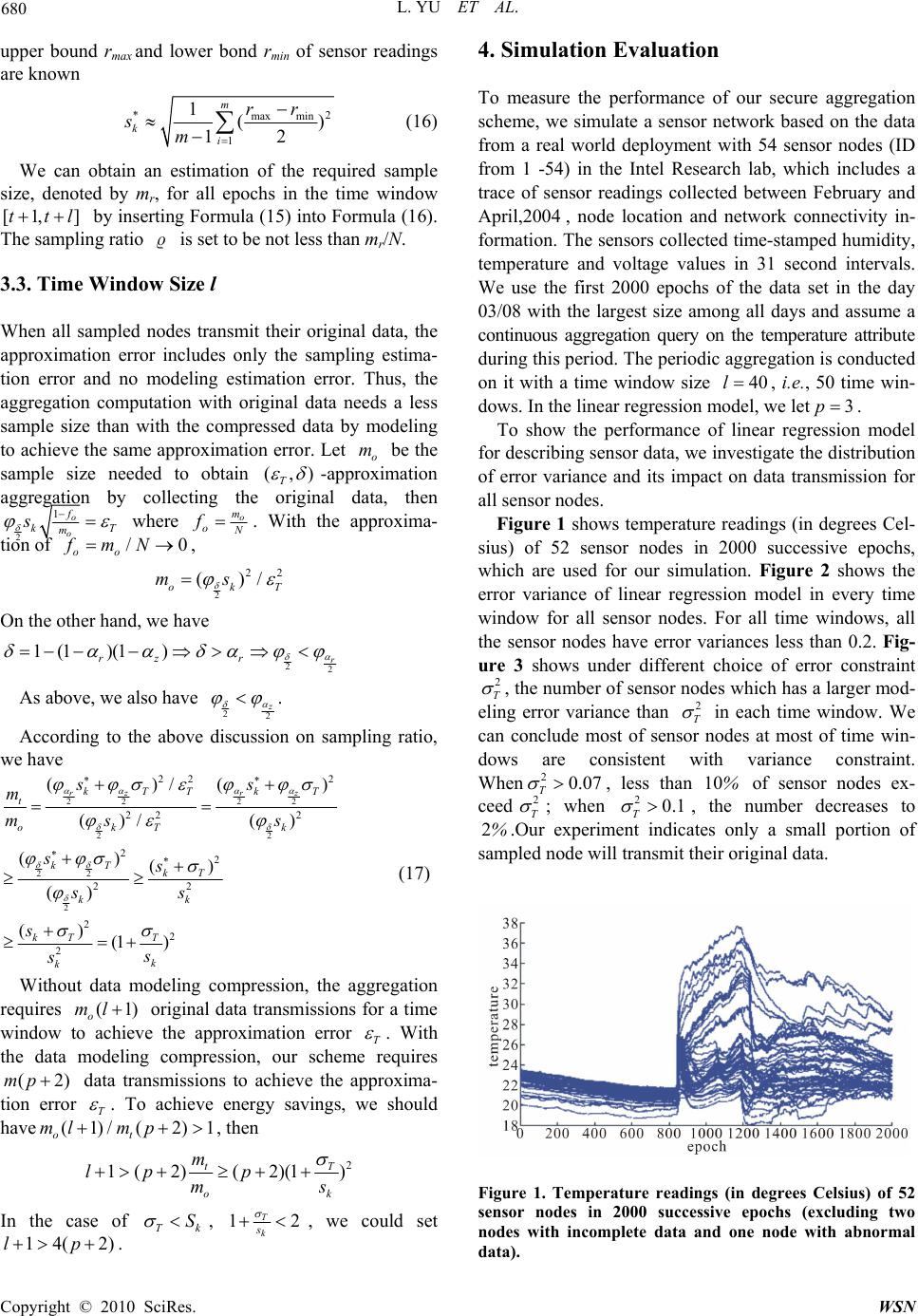 L. YU ET AL. Copyright © 2010 SciRes. WSN 680 upper bound rmax and lower bond rmin of sensor readings are known *2 max min 1 1() 12 m ki rr sm (16) We can obtain an estimation of the required sample size, denoted by mr, for all epochs in the time window [1 ]ttl by inserting Formula (15) into Formula (16). The sampling ratio is set to be not less than mr/N. 3.3. Time Window Size l When all sampled nodes transmit their original data, the approximation error includes only the sampling estima- tion error and no modeling estimation error. Thus, the aggregation computation with original data needs a less sample size than with the compressed data by modeling to achieve the same approximation erro r. Let o m be the sample size needed to obtain () T -approximation aggregation by collecting the original data, then 2 1o o f kT m s where o m o N f. With the approxima- tion of /0 oo fmN, 2 22 () okT ms On the other hand, we have 22 1(1 )(1 )r rz r As above, we also have 22 z . According to the above discussion on sampling ratio, we have 22 22 22 22 2 22 2 22 2 22 22 22 2 ()() () () () () () () (1 ) rzrz kTT kT t okT k kT kT kk kT T k k ss m mss ss ss s s s (17) Without data modeling compression, the aggregation requires (1) o ml original data tran smissions for a time window to achieve the approximation error T . With the data modeling compression, our scheme requires (2)mp data transmissions to achieve the approxima- tion error T . To achieve energy savings, we should have (1)/( 2)1 ot ml mp, then 2 1( 2)( 2)(1) tT ok m lp p ms In the case of Tk S , 12 T k s , we could set 14( 2)lp . 4. Simulation Evaluation To measure the performance of our secure aggregation scheme, we simulate a sensor network based on the data from a real world deployment with 54 sensor nodes (ID from 1 -54) in the Intel Research lab, which includes a trace of sensor readings collected between February and April,2004 , node location and network connectivity in- formation. The sensors collected time-stamped humidity, temperature and voltage values in 31 second intervals. We use the first 2000 epochs of the data set in the day 03/08 with the largest size among all days and assume a continuous aggregation query on the temperature attribute during this period. The periodic aggregation is conducted on it with a time window size 40l, i.e., 50 time win- dows. In the linear regression model, we let3p . To show the performance of linear regression model for describing sensor data, we investigate the distribution of error variance and its impact on data transmission for all sensor nodes. Figure 1 shows temperature readings (in degrees Cel- sius) of 52 sensor nodes in 2000 successive epochs, which are used for our simulation. Figure 2 shows the error variance of linear regression model in every time window for all sensor nodes. For all time windows, all the sensor nodes have error variances less than 0.2. Fig- ure 3 shows under different choice of error constraint 2 T , the number of sensor nodes which has a larger mod- eling error variance than 2 T in each time window. We can conclude most of sensor nodes at most of time win- dows are consistent with variance constraint. When 2007 T , less than 10% of sensor nodes ex- ceed 2 T ; when 201 T , the number decreases to 2%.Our experiment indicates only a small portion of sampled node will transmit their original data. Figure 1. Temperature readings (in degrees Celsius) of 52 sensor nodes in 2000 successive epochs (excluding two nodes with incomplete data and one node with abnormal data). 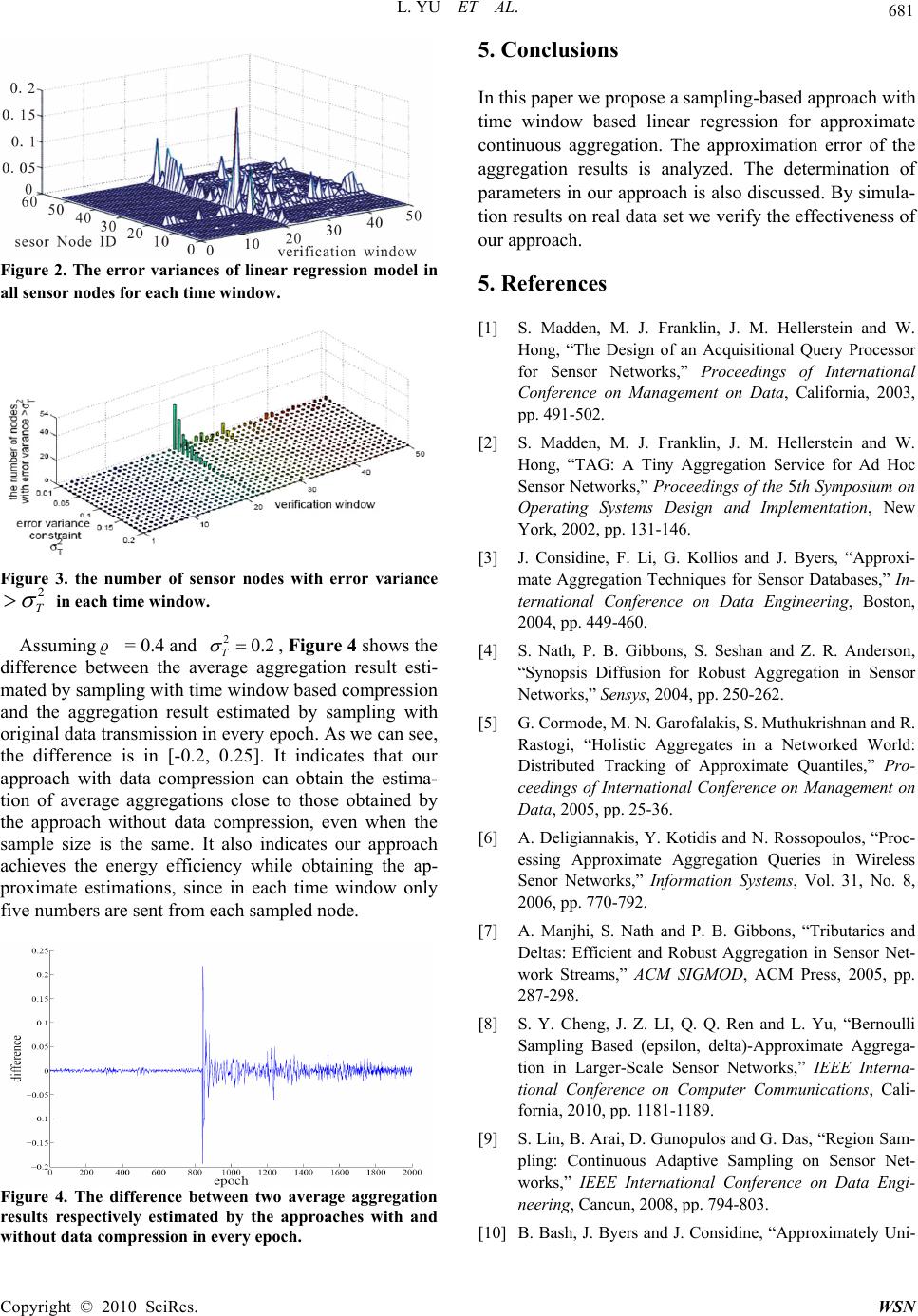 L. YU ET AL. Copyright © 2010 SciRes. WS N 681 Figure 2. The error variances of linear regression model in all sensor nodes for each time window. Figure 3. the number of sensor nodes with error variance 2 T in each time window. Assuming = 0.4 and 202 T , Figure 4 shows the difference between the average aggregation result esti- mated by sampling with time window based compression and the aggregation result estimated by sampling with original data transmission in every epoch. As we can see, the difference is in [-0.2, 0.25]. It indicates that our approach with data compression can obtain the estima- tion of average aggregations close to those obtained by the approach without data compression, even when the sample size is the same. It also indicates our approach achieves the energy efficiency while obtaining the ap- proximate estimations, since in each time window only five numbers are sent from each sampled node. Figure 4. The difference between two average aggregation results respectively estimated by the approaches with and without data compression in every epoch. 5. Conclusions In this paper we propose a sampling-based approach with time window based linear regression for approximate continuous aggregation. The approximation error of the aggregation results is analyzed. The determination of parameters in our approach is also discussed. By simula- tion results on real data set we verify th e effectiveness of our approach. 5. References [1] S. Madden, M. J. Franklin, J. M. Hellerstein and W. Hong, “The Design of an Acquisitional Query Processor for Sensor Networks,” Proceedings of International Conference on Management on Data, California, 2003, pp. 491-502. [2] S. Madden, M. J. Franklin, J. M. Hellerstein and W. Hong, “TAG: A Tiny Aggregation Service for Ad Hoc Sensor Networks,” Proceedings of the 5th Symposium on Operating Systems Design and Implementation, New York, 2002, pp. 131-146. [3] J. Considine, F. Li, G. Kollios and J. Byers, “Approxi- mate Aggregation Techniques for Sensor Databases,” In- ternational Conference on Data Engineering, Boston, 2004, pp. 449-460. [4] S. Nath, P. B. Gibbons, S. Seshan and Z. R. Anderson, “Synopsis Diffusion for Robust Aggregation in Sensor Networks,” Sensys, 2004, pp. 250-262. [5] G. Cormode, M. N. Garofalakis, S. Muthukrishnan and R. Rastogi, “Holistic Aggregates in a Networked World: Distributed Tracking of Approximate Quantiles,” Pro- ceedings of International Conference on Management on Data, 2005, pp. 25-36. [6] A. Deligiannakis, Y. Kotidis and N. Rossopoulos, “Proc- essing Approximate Aggregation Queries in Wireless Senor Networks,” Information Systems, Vol. 31, No. 8, 2006, pp. 770-792. [7] A. Manjhi, S. Nath and P. B. Gibbons, “Tributaries and Deltas: Efficient and Robust Aggregation in Sensor Net- work Streams,” ACM SIGMOD, ACM Press, 2005, pp. 287-298. [8] S. Y. Cheng, J. Z. LI, Q. Q. Ren and L. Yu, “Bernoulli Sampling Based (epsilon, delta)-Approximate Aggrega- tion in Larger-Scale Sensor Networks,” IEEE Interna- tional Conference on Computer Communications, Cali- fornia, 2010, pp. 1181-1189. [9] S. Lin, B. Arai, D. Gunopulos and G. Das, “Region Sam- pling: Continuous Adaptive Sampling on Sensor Net- works,” IEEE International Conference on Data Engi- neering, Cancun, 2008, pp. 794-803. [10] B. Bash, J. Byers and J. Considine, “Approximately Uni- 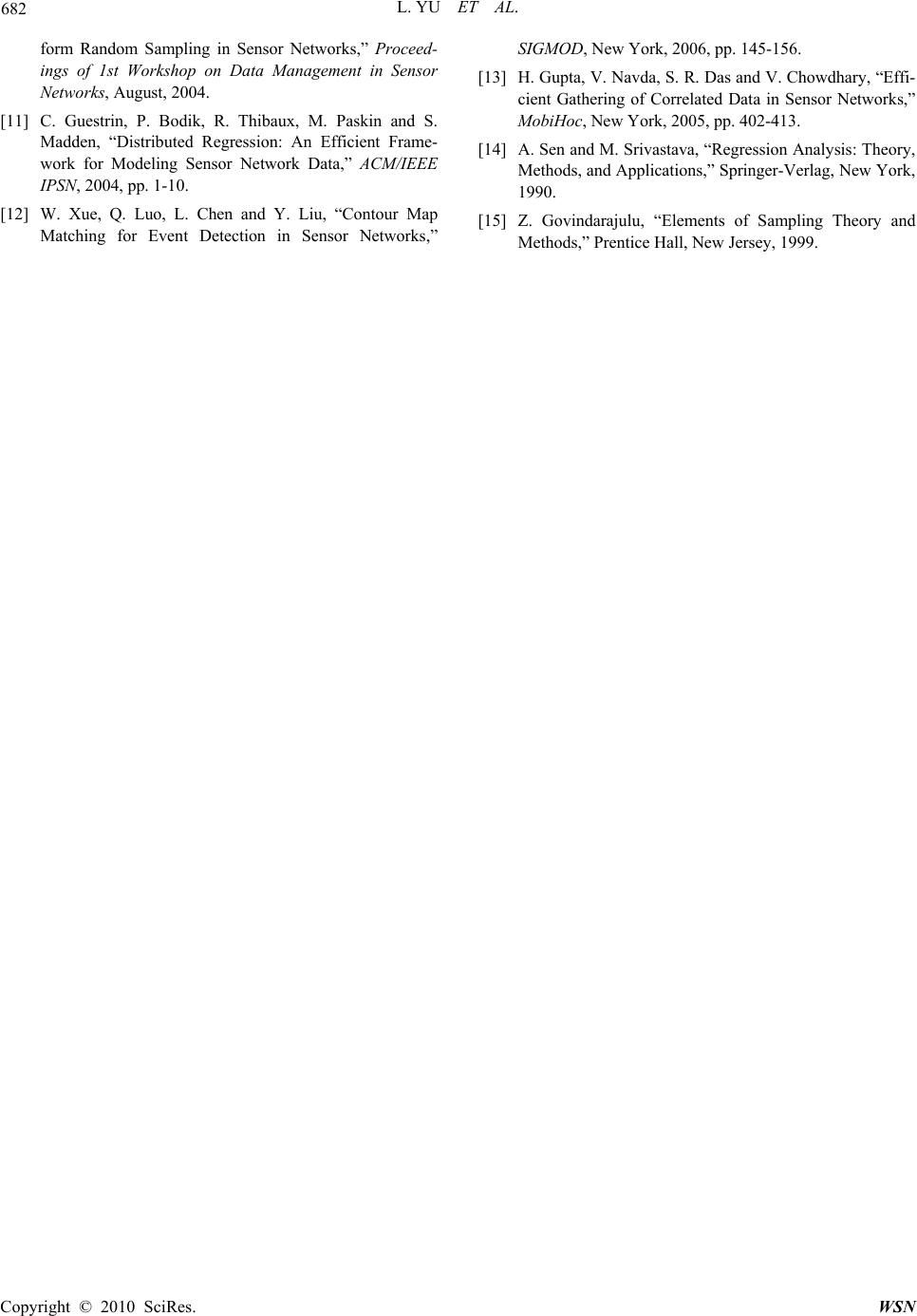 L. YU ET AL. Copyright © 2010 SciRes. WSN 682 form Random Sampling in Sensor Networks,” Proceed- ings of 1st Workshop on Data Management in Sensor Networks, August, 2004. [11] C. Guestrin, P. Bodik, R. Thibaux, M. Paskin and S. Madden, “Distributed Regression: An Efficient Frame- work for Modeling Sensor Network Data,” ACM/IEEE IPSN, 2004, pp. 1-10. [12] W. Xue, Q. Luo, L. Chen and Y. Liu, “Contour Map Matching for Event Detection in Sensor Networks,” SIGMOD, New York, 2006, pp. 145-156. [13] H. Gupta, V. Navda, S. R. Das and V. Chowdhary, “Effi- cient Gathering of Correlated Data in Sensor Networks,” MobiHoc, New York, 2005, pp. 402-413. [14] A. Sen and M. Srivastava, “Regression Analysis: Theory, Methods, and Applications,” Springer-Verlag, New York, 1990. [15] Z. Govindarajulu, “Elements of Sampling Theory and Methods,” Prentice Hall, New Jersey, 1999. |

